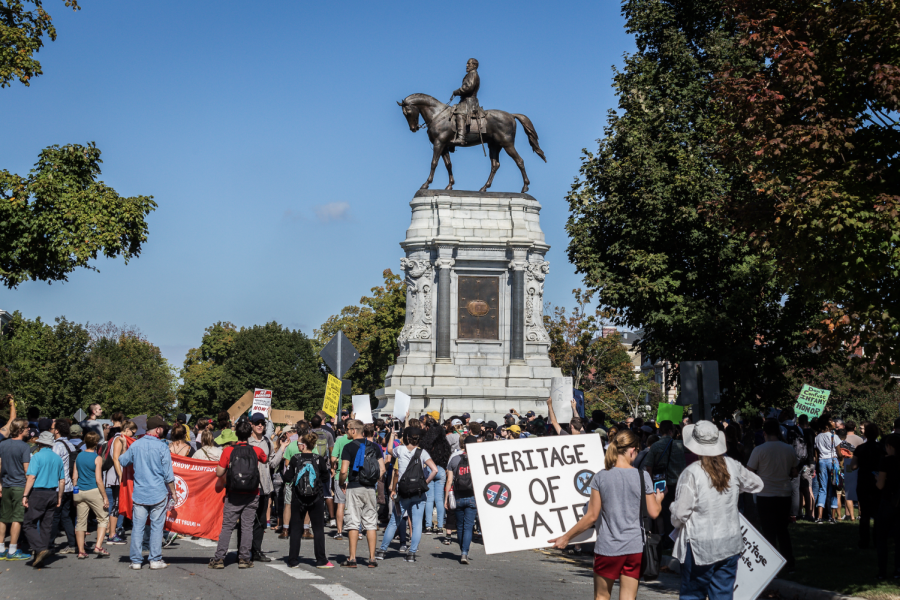Not All History Is Made Equal
Hundreds of marchers rally at the Robert E. Lee statue on Monument Avenue, in Richmond, Virginia on September 16, 2017 | Photo Credit: https://www.flickr.com/photos/mobili/37109128732/in/photostream/, CC BY-SA 2.0
History is a fickle thing. Every artifact comes with context to consider, along with the evolving perception of that artifact. Inevitably, controversy will surround historical events and the artifacts that come from them, but few artifacts evoke controversy like confederate statues. That was on full display earlier this month when officials in Richmond, Virginia, removed the statue of Robert E. Lee.

While some have argued that removing these statues destroys history, the truth points in the opposite direction. Like many of the confederate statues before it, the Lee statue is an extension of an ahistorical and propaganda movement known as the Lost Cause. The Lost Cause, largely promoted by former confederates and pro-confederate movements like the United Daughters of the Confederacy, argues that slavery was not the root cause of the Civil War. By making this argument, Southerners and former confederates could justify all the death and suffering that ravaged their homes without taking responsibility for their contributions to it. As one confederate general put it, “If we cannot justify the South in the act of Secession, we will go down in History [sic] solely as a brave, impulsive but rash people who attempted in an illegal manner to overthrow the Union for our Country.”
Confederates like former General Jubal Early, Edward Pollard, and ex-Confederacy president Jefferson Davis did everything in their power to promote the idea that the Confederacy was a martyr to a noble cause. Pollard is perhaps the most infamous among the three, as it was his memoir The Lost Cause: A New Southern History of the War of the Confederates (1866) that helped spawn much of what would become the Lost Cause. Like Early and many of those who came after him, Pollard claimed that the war had little to nothing to do with slavery and that the South fought for states’ rights. This is fiction, especially when considering the confederate constitution, and a majority of the states in the Confederacy heavily emphasized slavery as a part of their society. In their constitution, the confederates made their purpose self-evident, stating that “No bill of attainder, ex ‘post facto law, or law denying or impairing the right of property in negro slaves shall be passed.”

With such blatant evidence against their myth, supporters of the Lost Cause glorified various figures from the war as symbols of Southern valor and prowess. Lee was foremost among these mythical figures. Edward Bonekemper’s The Myth of the Lost Cause: Why the South Fought the Civil War and Why the North Won (2015) rightfully takes a shot at this valorization, noting that Lee had higher casualty rates than his victorious Northern rival, Ulysses S. Grant. But that did not stop many of these pro-confederate activists from making him into a symbol.
In 1890, the Lee Statue was erected thanks to the combined effort of Jubal Early, the Lee Ladies Memorial Association, and the now-defeated Army of Northern Virginia. Through this statue and the many that would adorn that same street, Lost Causers could hide behind their myth, all while laws passed throughout the South to reinforce the racialized subjugation the Confederacy once fought to maintain.
The Lee monument is but one part of the larger issue surrounding history and how we remember it. Much more pernicious is the way we ignore the continued effort to conceal and misrepresent the past. The United Daughters of the Confederacy, which is largely to blame for hundreds of the monuments that dot the country, remains at large.

To this day, the UDC fights to keep these monuments from being removed and actively promotes a glorified version of its past. On their website, the UDC’s president, Lind Edwards, wrote, “The United Daughters of the Confederacy totally denounces any individual or group that promotes racial divisiveness or white supremacy. And we call on these people to cease using Confederate symbols for their abhorrent and reprehensible purposes”. But when the organization was at its zenith, it supported every component of those values. Not only did they actively promote statues like the Lee monument in Virginia, but they dedicated their time and money to promoting the KKK. One of their main authors’ book infamously titled The Klu Klux Klan or Invisible Empire, which promoted the idea that the Klan was “glorious” and heroic to the South. From the very beginning, these organizations intended to spread, not remove, racism from the South. Laura Martin Rose, book infamously titled The Klu Klux Klan or Invisible Empire, which promoted the idea that the Klan was “glorious” and heroic to the South. From the very beginning, these organizations intended to spread, not remove, racism from the South.
It is one thing to consider one’s biases and perspectives, to reserve judgment and consider the perspective of those who came before, but that does not mean critical thinking about history should end. Avoiding hindsight bias is not the same thing as turning a blind eye to uncomfortable truths. These monuments were, and always will be, a monument to their racist origins. And unless they are removed or recontextualized, their prejudiced influence on the American mind shall remain.











